11 Steps to Effective Social Media Crisis Management
Table of contents
Social media can create troubles called crises. That’s why having a social media crisis management plan is critical.
In this article, I’ll explain how to create such a plan.
It will help protect your brand’s reputation and ensure social media users still trust you.
Let’s dive in!
Social media crisis management plan:
- Secure your social media accounts
- Monitor brand mentions
- Identify the issue
- Monitor Reputation Score
- Establish a crisis management team
- Communicate with your employees
- Stop scheduled posts
- Establish social media guidelines
- Design a crisis communication plan
- Respond to social media users
- Evaluate your crisis response
What is a social media crisis?
A social media crisis is a destructive and unexpected event that happens on social media. It can hurt an organization’s reputation.
A crisis can happen because of many things, like unhappy customers, bad reviews, or cyberbullying.
Crises can spread quickly on social media and cause problems for brands. You must act quickly and communicate well to deal with social media crises.

Discover our client’s success story — read the case study.
What is not a social media crisis?
Not everything bad on social media is a crisis. Negative feedback, small errors, routine issues, rumors, and unrelated events are not crises.
Not every negative mention is a social media crisis. You can’t please everyone. People will voice their opinions online.
Some of them will be critical of your company or product. That’s nothing a seasoned social media team can’t handle.

A crisis is a serious problem that can harm an organization’s reputation, finances, or legal standing.
To set benchmarks, you need to monitor your social media channels. Once you know what to expect, you can easily spot the spikes in engagement or negative mentions.
To detect a social media crisis, watch for spikes in activity. If you notice a sudden increase in negative comments or mentions, it could be a sign of trouble.
Here you can see the rise of negative mentions of the Adidas brand. They were related to Kanye West and his controversial opinions. Yes, it was definitely an image crisis for the brand. As a result, Adidas ended its partnership with the rapper.
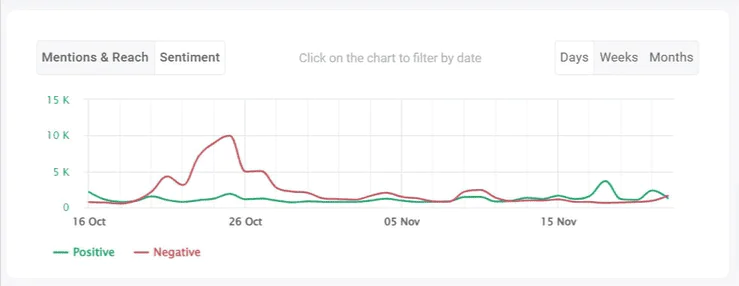
Start effective crisis management on social media!
Social media crisis management plan
Without further ado, let’s take a closer look at the bulletproof social media crisis management tips. I hope they will help you design a solid crisis scenario.
The first steps describe what you should do before a social media crisis.
01 Secure your social media accounts
Many social media crises start with a hostile takeover. It can happen either by an employee who left the company and wants revenge or by password leak.
You can take several actions to minimize the chances of social media takeover.
First, minimize the number of people with passwords to your social media accounts. A password system will allow you to implement strong passwords. Also, it will help you revoke the access of the employees who no longer need them.
Secondly, always set up a two-factor authentication system. This will give you greater control over who tries to log in to your accounts.
Remember to revoke access for employees who no longer work for you.
02 Monitor brand mentions
Brand mentions monitoring is essential to detect the unexpecting crisis on social media.
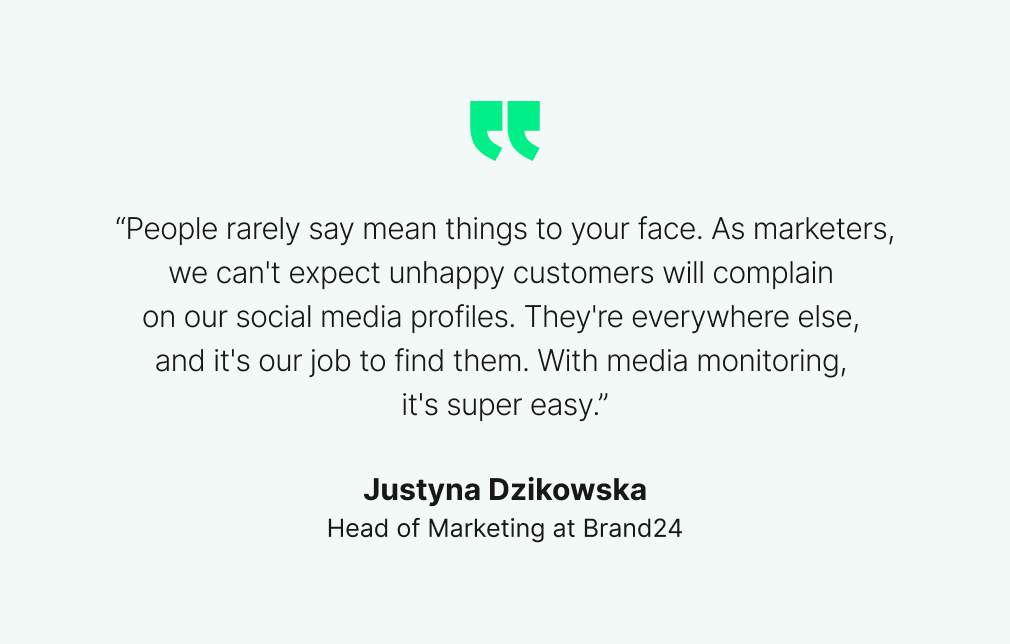
Fortunately, social media monitoring tools can support you when a crisis occurs:
- Early detection – Tools can detect potential crises early on by tracking mentions of a brand on social media platforms. What’s important is that tools like Brand24 can send you a storm alert. So they will notify you if they detect a rapid increase in your media mentions volume.
- Real-time monitoring – During a crisis, they monitor the conversation in real time and allow social media managers to respond quickly.
- Response management – Using tools, the team can quickly identify negative comments and posts. It will help them to respond promptly and professionally to reduce the impact of the crisis on the brand’s reputation.
- Social media sentiment analysis – Tools provide sentiment analysis to understand how people feel about the brand during a crisis.
- Online reputation score – It’s a very insightful metric. It will help you track your online reputation. But not every tool measures it. To find out your brand’s reputation score, use Brand24.
Overall, mentions monitoring helps identify potential issues early on, monitor the conversation, and reduce the negative impact of the crisis.

Monitor your brand and detect negative mentions!
03 Identify the issue
So, you are in the middle of a crisis. It’s time to detect the source of the issue:
- Look at past social media mentions, customer complaints, and product reviews to see if there are any recurring issues.

- Conduct a sentiment analysis to detect social media platforms that are a source of negative comments and mentions.

- Track the context of a discussion to detect which topics generate negative sentiment.
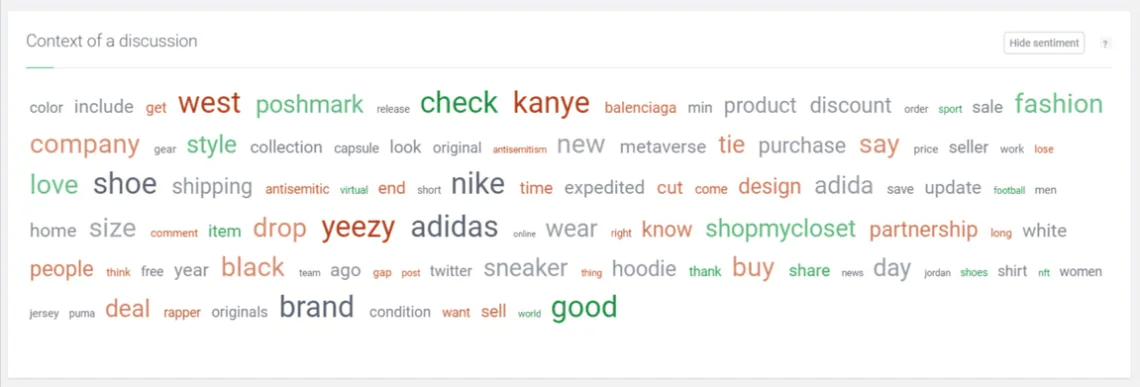
04 Monitor Reputation Score
Online Reputation Score is one of the key social media metrics. It will show you how well your brand performs online.
During the crisis, the score will decrease. But after implementing strategies to improve your image, it should increase.
Tracking the reputation score is a great way to detect a crisis very early. That’s why I recommend you pay attention to it.
You can check your score here.

Check: The best online reputation management software
Monitor the Reputation Score of your brand!
05 Establish a crisis management team
You need a team with clear roles and responsibilities to manage a crisis. Each team member should have a clear role and responsibility.
The team should include representatives from different departments within the company. This way, all relevant people will participate in the decision-making process. Train them to handle a crisis so they’re ready when it happens.
06 Communicate with your employees
It’s vital that your employees know exactly what is going on. One thing you don’t need during a social media crisis is gossip among your employees.
Make sure everyone is on the same page. Every employee should know what they can and cannot say about the crisis. This will help you contain the spread of misinformation and rumors.
Internal communication can empower employees to be more involved in the social media response process and take ownership of the situation.
Hopefully, these tips will help you survive a social media crisis. But social media crisis management doesn’t stop here. There is still one step ahead of you — the post-social media crisis management.
07 Stop scheduled posts
Your social media manager probably has a fully booked calendar.
But once a crisis hits your brand, it’s time to stop all scheduled content. Scheduled communication will make you look silly and further damage your brand.
For example, if a company has scheduled sales posts and a crisis occurs, the posts may appear tone-deaf.
Some pre-scheduled social media posts can hinder all your crisis control efforts.
Once you start implementing social media crisis communication plan, stop all scheduled posts.
Monitor your brand and detect negative mentions!
08 Establish social media guidelines
Your weakest link during the crisis might be one of your employees. The good news is it’s relatively easy to protect yourself against rough employees.
Creating a social media guide is a good idea to prevent employees from starting a social media crisis.
Add all the do’s and don’ts to the guideline.
Of course, the guideline will vary according to your business niche and social media strategy. But it’s generally a good idea to add the following rules:
- Copyright – That’s an absolute basic, no matter what company you run. Every employee accessing your social media accounts should know how to use and credit content.
- Privacy – Some interactions with your audience should occur in an open space, while others should be moved to private messages. Make sure everyone knows the difference.
- Brand voice – Is your company’s voice formal or informal? Do you joke around? Make sure everyone knows how to post.
- Brand style – Social media are visual platforms. Ensure all your posts, stories, and movies are aligned.
09 Design a crisis communication plan
Before a social media crisis hits, you should prepare a crisis communication plan.
A crisis communication plan will ensure that you will act fast and efficiently. Your social media crisis response team will know how to act and won’t have to wait for C-level decisions.
A crisis communication plan should detail who is responsible for what. Everyone in the company should know what to do, from the C-level to the most junior employees.
Remember to prepare two means of communication — internal and external. Your employees should know what is going on and receive regular company updates.
On the other hand, you should also include external communication guidelines. First, draft messages you could post on your official channels. Secondly, develop an approval process for your official communication.
You might wonder why you should prepare draft messages. You never know what type of crisis will hit you.
And once you have to deal with a full-blown social media crisis, you will have to act fast. A crisis communication plan will ensure that people will know what to do.
Here are some best practices for communication during a crisis on social media:
- Respond quickly and honestly – Respond to the crisis as quickly as possible. Be transparent about what happened. Provide accurate information about the situation.
- Use a consistent message and tone – Use a consistent tone and message in all communications related to the crisis. It will make you more credible.
- Monitor social media and respond to them – Monitor social media channels closely for crisis mentions. Try to respond to all of them. Even if you don’t have all the answers, letting people know you are working on a solution will help build trust.
- Be empathetic – Show empathy and concern for those affected by the crisis. This can help defuse tense situations and build goodwill with social media users.
- Choose a spokesperson – Select a spokesperson who is well-informed about the situation. This person will communicate through social media and provide accurate information.
- Provide updates regularly – Deliver regular updates on the situation. Describe the efforts you’re making to rectify the situation. It will keep your followers informed and reduce speculation and rumors.
10 Respond to social media users
Your communication plan should contain a detailed response to the crisis. Once you post the first message and acknowledge the social media crisis, it’s time to engage on social media.
There are a couple of rules you should follow:
- Be present on social media – Once a social media crisis hits, hiding is not a good idea. Brace yourself and respond to comments and questions.
- Never get emotional – Internet users will express a lot of negative comments. You should answer them calmly and try to resolve any heated discussion in private messages.
- Don’t defend your position at all costs – Some people will argue with you just for the sake of argument. If you see that the discussion is going nowhere, simply state your position clearly and stop answering.
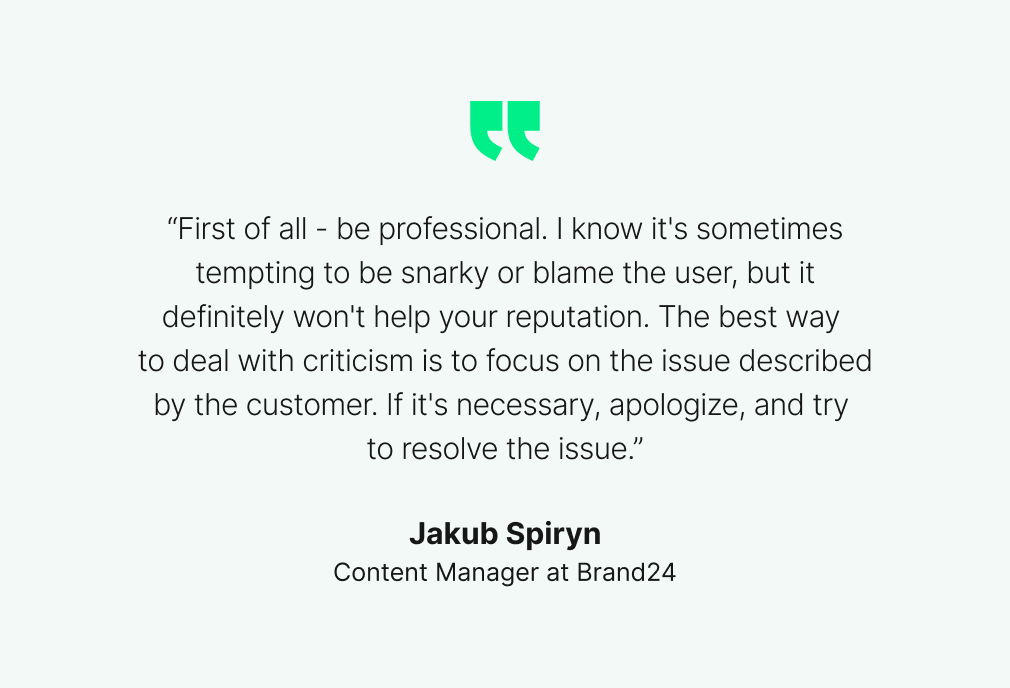
11 Evaluate your crisis response
Learn from experience.
Once you stave off the social media crisis, debrief your team and examine what happened. Note everything you have done and determine the effects of your actions.
Speak with members of all teams and identify the strong and weak points of your social media crisis response. Other departments can share interesting insights you can implement into your social media crisis management plan.
Monitor your brand and detect negative mentions!
Conclusion
A social media crisis can happen to any brand, big or small.
The key to successfully managing a crisis is to be prepared, stay calm, and prioritize communication.
Key takeaways:
- To effectively manage a social media crisis, you need to be prepared and don’t panic once a crisis hits.
- Preparing for a crisis will save you some time in the first phase. You can use this time to prepare for the second social media crisis management phase.
- Stay calm during the crisis and engage with your followers. Present your side of the story and try to resolve the most heated discussions in private communication.
- Remember that a crisis can show your brand’s values and dedication to your customers.
- With the right approach, you can turn a crisis into an opportunity to strengthen your relationship with your audience.
- Social media monitoring tools can help you manage and prevent crises.
In the end, evaluate your crisis management approach. There are aspects of your communication you can improve to prepare better for the next crisis.
Start monitoring your brand mentions!
FAQ
What is crisis management in social media?
Crisis management in social media refers to the process of effectively handling and navigating through potentially damaging situations that may arise on social media platforms. Successful crisis management involves identifying, addressing, and mitigating the impact of a potential crisis, as well as taking proactive steps to prevent future crises.
What are the 4 stages of social media crisis communication?
The four stages of social media crisis communication are the following:
a. Preparation: Assemble a crisis communications team and develop a comprehensive plan to manage social media channels in case of an emergency.
b. Identification: Monitor social media for early signs of a crisis and swiftly identify any potential risks or threats.
c. Response: Implement the crisis plan, and address the issue on social media platforms. This may involve releasing official statements, providing updates, and responding to public concerns.
d. Recovery: Evaluate the effectiveness of the response, make necessary adjustments to the crisis plan, and continue monitoring social media to ensure the situation is resolved and to prevent future crises.
Is social media a crisis management tool?
Yes, social media can be an effective crisis management tool. It enables organizations to quickly communicate with their audience during a crisis, providing timely updates and addressing concerns. A well-prepared social team can use social media to monitor and respond to potential threats, as well as to share accurate information and demonstrate transparency throughout the crisis. This can help minimize the negative impact of a crisis and maintain trust with stakeholders.
What is an example of media crisis?
A real-world example of a media crisis is the United Airlines incident in 2017. In this case, a passenger was forcibly removed from an overbooked flight, resulting in injuries. The incident was recorded by other passengers and quickly went viral on social media, causing widespread outrage and negative publicity for the airline. United Airlines’ initial response was perceived as inadequate, which further fueled the crisis. In response, the company entered crisis mode, with community managers working to address public concerns, apologize, and communicate policy changes to prevent similar incidents in the future. This example illustrates the importance of effective crisis management in social media to mitigate damage to a company’s reputation and restore trust with stakeholders.
Related articles


![What is AI Social Media Monitoring? Definition [Guide]](https://brand24.com/blog/app/uploads/2022/09/What-is-Social-Media-Monitoring.png)

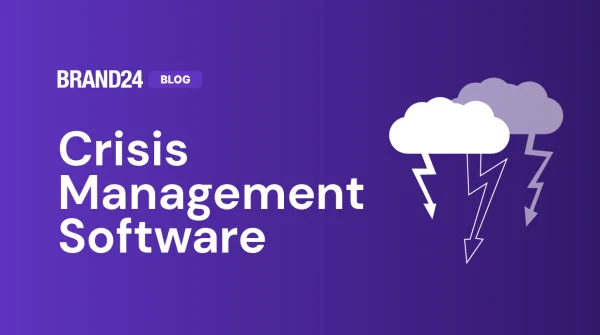
![How to Measure Crisis Performance? [2025]](https://brand24.com/blog/app/uploads/2024/06/crisis_performance-600x335.webp)